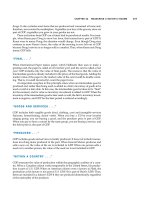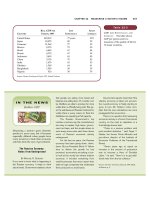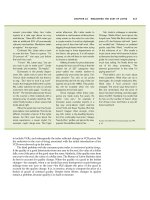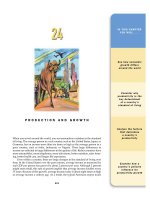Ten Principles of Economics - Part 3
Bạn đang xem bản rút gọn của tài liệu. Xem và tải ngay bản đầy đủ của tài liệu tại đây (231.62 KB, 10 trang )
CHAPTER 2 THINKING LIKE AN ECONOMIST 23
are not actual human bodies, and no one would mistake the model for a real per-
son. These models are stylized, and they omit many details. Yet despite this lack of
realism—indeed, because of this lack of realism—studying these models is useful
for learning how the human body works.
Economists also use models to learn about the world, but instead of being
made of plastic, they are most often composed of diagrams and equations. Like
a biology teacher’s plastic model, economic models omit many details to allow
us to see what is truly important. Just as the biology teacher’s model does not in-
clude all of the body’s muscles and capillaries, an economist’s model does not
include every feature of the economy.
As we use models to examine various economic issues throughout this book,
you will see that all the models are built with assumptions. Just as a physicist be-
gins the analysis of a falling marble by assuming away the existence of friction,
economists assume away many of the details of the economy that are irrelevant for
studying the question at hand. All models—in physics, biology, or economics—
simplify reality in order to improve our understanding of it.
OUR FIRST MODEL: THE CIRCULAR-FLOW DIAGRAM
The economy consists of millions of people engaged in many activities—buying,
selling, working, hiring, manufacturing, and so on. To understand how the econ-
omy works, we must find some way to simplify our thinking about all these activ-
ities. In other words, we need a model that explains, in general terms, how the
economy is organized and how participants in the economy interact with one
another.
Figure 2-1 presents a visual model of the economy, called a circular-flow
diagram. In this model, the economy has two types of decisionmakers—house-
holds and firms. Firms produce goods and services using inputs, such as labor,
land, and capital (buildings and machines). These inputs are called the factors of
production. Households own the factors of production and consume all the goods
and services that the firms produce.
Households and firms interact in two types of markets. In the markets for
goods and services, households are buyers and firms are sellers. In particular,
households buy the output of goods and services that firms produce. In the mar-
kets for the factors of production, households are sellers and firms are buyers. In
these markets, households provide firms the inputs that the firms use to produce
goods and services. The circular-flow diagram offers a simple way of organizing
all the economic transactions that occur between households and firms in the
economy.
The inner loop of the circular-flow diagram represents the flows of goods and
services between households and firms. The households sell the use of their labor,
land, and capital to the firms in the markets for the factors of production. The firms
then use these factors to produce goods and services, which in turn are sold
to households in the markets for goods and services. Hence, the factors of produc-
tion flow from households to firms, and goods and services flow from firms to
households.
The outer loop of the circular-flow diagram represents the corresponding flow
of dollars. The households spend money to buy goods and services from the
firms. The firms use some of the revenue from these sales to pay for the factors of
circular-flow diagram
a visual model of the economy that
shows how dollars flow through
markets among households and firms
24 PART ONE INTRODUCTION
production, such as the wages of their workers. What’s left is the profit of the firm
owners, who themselves are members of households. Hence, spending on goods
and services flows from households to firms, and income in the form of wages,
rent, and profit flows from firms to households.
Let’s take a tour of the circular flow by following a dollar bill as it makes its
way from person to person through the economy. Imagine that the dollar begins at
a household, sitting in, say, your wallet. If you want to buy a cup of coffee, you
take the dollar to one of the economy’s markets for goods and services, such as
your local Starbucks coffee shop. There you spend it on your favorite drink. When
the dollar moves into the Starbucks cash register, it becomes revenue for the firm.
The dollar doesn’t stay at Starbucks for long, however, because the firm uses it to
buy inputs in the markets for the factors of production. For instance, Starbucks
might use the dollar to pay rent to its landlord for the space it occupies or to pay
the wages of its workers. In either case, the dollar enters the income of some
household and, once again, is back in someone’s wallet. At that point, the story of
the economy’s circular flow starts once again.
The circular-flow diagram in Figure 2-1 is one simple model of the economy. It
dispenses with details that, for some purposes, are significant. A more complex
Spending
Goods and
services
bought
Revenue
Goods
and services
sold
Labor, land,
and capital
Income
ϭ Flow of goods
and services
ϭ Flow of dollars
Inputs for
production
Wages, rent,
and profit
FIRMS
• Produce and sell
goods and services
• Hire and use factors
of production
• Buy and consume
goods and services
• Own and sell factors
of production
HOUSEHOLDS
• Households sell
• Firms buy
MARKETS
FOR
FACTORS OF PRODUCTION
• Firms sell
• Households buy
MARKETS
FOR
GOODS AND SERVICES
Figure 2-1
T
HE
C
IRCULAR
F
LOW
. This
diagram is a schematic represen-
tation of the organization of the
economy. Decisions are made by
households and firms. House-
holds and firms interact in the
markets for goods and services
(where households are buyers
and firms are sellers) and in the
markets for the factors of
production (where firms are
buyers and households are
sellers). The outer set of arrows
shows the flow of dollars, and the
inner set of arrows shows the
corresponding flow of goods and
services.
CHAPTER 2 THINKING LIKE AN ECONOMIST 25
and realistic circular-flow model would include, for instance, the roles of govern-
ment and international trade. Yet these details are not crucial for a basic under-
standing of how the economy is organized. Because of its simplicity, this
circular-flow diagram is useful to keep in mind when thinking about how the
pieces of the economy fit together.
OUR SECOND MODEL: THE PRODUCTION
POSSIBILITIES FRONTIER
Most economic models, unlike the circular-flow diagram, are built using the tools
of mathematics. Here we consider one of the simplest such models, called the pro-
duction possibilities frontier, and see how this model illustrates some basic eco-
nomic ideas.
Although real economies produce thousands of goods and services, let’s imag-
ine an economy that produces only two goods—cars and computers. Together the
car industry and the computer industry use all of the economy’s factors of pro-
duction. The production possibilities frontier is a graph that shows the various
combinations of output—in this case, cars and computers—that the economy can
possibly produce given the available factors of production and the available pro-
duction technology that firms can use to turn these factors into output.
Figure 2-2 is an example of a production possibilities frontier. In this economy,
if all resources were used in the car industry, the economy would produce 1,000
cars and no computers. If all resources were used in the computer industry, the
economy would produce 3,000 computers and no cars. The two end points of
the production possibilities frontier represent these extreme possibilities. If the
1,000
2,200
Production
possibilities
frontier
A
B
C
Quantity of
Cars Produced
7006003000
2,000
3,000
1,000
Quantity of
Computers
Produced
D
Figure 2-2
T
HE
P
RODUCTION
P
OSSIBILITIES
F
RONTIER
. The production
possibilities frontier shows the
combinations of output—in this
case, cars and computers—that
the economy can possibly
produce. The economy can
produce any combination on or
inside the frontier. Points outside
the frontier are not feasible given
the economy’s resources.
production possibilities
frontier
a graph that shows the combinations
of output that the economy can
possibly produce given the available
factors of production and the
available production technology
26 PART ONE INTRODUCTION
economy were to divide its resources between the two industries, it could produce
700 cars and 2,000 computers, shown in the figure by point A. By contrast, the out-
come at point D is not possible because resources are scarce: The economy does
not have enough of the factors of production to support that level of output. In
other words, the economy can produce at any point on or inside the production
possibilities frontier, but it cannot produce at points outside the frontier.
An outcome is said to be efficient if the economy is getting all it can from the
scarce resources it has available. Points on (rather than inside) the production pos-
sibilities frontier represent efficient levels of production. When the economy is pro-
ducing at such a point, say point A, there is no way to produce more of one good
without producing less of the other. Point B represents an inefficient outcome. For
some reason, perhaps widespread unemployment, the economy is producing less
than it could from the resources it has available: It is producing only 300 cars and
1,000 computers. If the source of the inefficiency were eliminated, the economy
could move from point B to point A, increasing production of both cars (to 700)
and computers (to 2,000).
One of the Ten Principles of Economics discussed in Chapter 1 is that people face
tradeoffs. The production possibilities frontier shows one tradeoff that society
faces. Once we have reached the efficient points on the frontier, the only way of
getting more of one good is to get less of the other. When the economy moves from
point A to point C, for instance, society produces more computers but at the ex-
pense of producing fewer cars.
Another of the Ten Principles of Economics is that the cost of something is what
you give up to get it. This is called the opportunity cost. The production possibilities
frontier shows the opportunity cost of one good as measured in terms of the other
good. When society reallocates some of the factors of production from the car in-
dustry to the computer industry, moving the economy from point A to point C, it
gives up 100 cars to get 200 additional computers. In other words, when the econ-
omy is at point A, the opportunity cost of 200 computers is 100 cars.
Notice that the production possibilities frontier in Figure 2-2 is bowed out-
ward. This means that the opportunity cost of cars in terms of computers depends
on how much of each good the economy is producing. When the economy is using
most of its resources to make cars, the production possibilities frontier is quite
steep. Because even workers and machines best suited to making computers are
being used to make cars, the economy gets a substantial increase in the number of
computers for each car it gives up. By contrast, when the economy is using most of
its resources to make computers, the production possibilities frontier is quite flat.
In this case, the resources best suited to making computers are already in the com-
puter industry, and each car the economy gives up yields only a small increase in
the number of computers.
The production possibilities frontier shows the tradeoff between the produc-
tion of different goods at a given time, but the tradeoff can change over time. For
example, if a technological advance in the computer industry raises the number of
computers that a worker can produce per week, the economy can make more com-
puters for any given number of cars. As a result, the production possibilities fron-
tier shifts outward, as in Figure 2-3. Because of this economic growth, society
might move production from point A to point E, enjoying more computers and
more cars.
The production possibilities frontier simplifies a complex economy to high-
light and clarify some basic ideas. We have used it to illustrate some of the
CHAPTER 2 THINKING LIKE AN ECONOMIST 27
concepts mentioned briefly in Chapter 1: scarcity, efficiency, tradeoffs, opportunity
cost, and economic growth. As you study economics, these ideas will recur in
various forms. The production possibilities frontier offers one simple way of think-
ing about them.
MICROECONOMICS AND MACROECONOMICS
Many subjects are studied on various levels. Consider biology, for example. Molec-
ular biologists study the chemical compounds that make up living things. Cellular
biologists study cells, which are made up of many chemical compounds and, at
the same time, are themselves the building blocks of living organisms. Evolution-
ary biologists study the many varieties of animals and plants and how species
change gradually over the centuries.
Economics is also studied on various levels. We can study the decisions of in-
dividual households and firms. Or we can study the interaction of households and
firms in markets for specific goods and services. Or we can study the operation of
the economy as a whole, which is just the sum of the activities of all these decision-
makers in all these markets.
The field of economics is traditionally divided into two broad subfields.
Microeconomics is the study of how households and firms make decisions and
how they interact in specific markets. Macroeconomics is the study of economy-
wide phenomena. A microeconomist might study the effects of rent control on
housing in New York City, the impact of foreign competition on the U.S. auto in-
dustry, or the effects of compulsory school attendance on workers’ earnings. A
2,100
2,000
A
E
Quantity of
Cars Produced
700 750
0
4,000
3,000
1,000
Quantity of
Computers
Produced
Figure 2-3
AS
HIFT IN THE
P
RODUCTION
P
OSSIBILITIES
F
RONTIER
.An
economic advance in the
computer industry shifts the
production possibilities frontier
outward, increasing the number
of cars and computers the
economy can produce.
microeconomics
the study of how households and
firms make decisions and how they
interact in markets
macroeconomics
the study of economy-wide
phenomena, including inflation,
unemployment, and economic
growth









